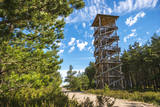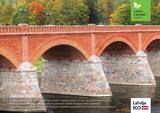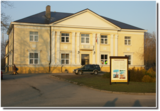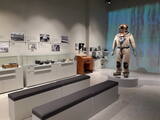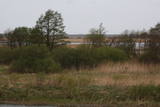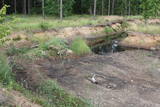| Нo | Название | Описание |
|---|---|---|
|
Находится в западной части Виесите, со стороны ул. Калькю на т.н. холме Валес (оставленный ледником оз). В качестве интересного факта стоит упомянуть то, что в 1919 году в этом месте защитники Виесите нанесли поражение армии Бермонта. Закладка камня церкви состоялась 15 августа 1937 года (в День памяти героев), освящение - в 1939 году, а восстановление - в 1994 году. Финансовую поддержку в строительстве храма оказывал профессор Пауль Страдиньш. В храме находится алтарная икона Л. Цауне. К востоку от церкви, у подножья холма Валес установлен памятник П. Страдиньшу. |
||
|
The barrow which offers a good view is at the northern end of the Dunduri meadows – at the end of Melnragi. It is an artificial barrow which follows along with the bed of the little Slampe River. The meadows are home to livestock allowed to live in the wild, and you can see a bit of the restored Slampe. The view is particularly interesting during flooding season, when the surrounding wetlands become saturated. This is a location for bird-watching.
|
||
|
Koka skatu tornis atrodas blakus Kolkasraga priežu takai. No tā redzama ar priedītēm aizaugusi „stiga” – t.s. Šautuve, kuru padomju laikā izmantoja šaušanas apmācībām. No torņa skatu platformas labi saskatāma Kolkas bāka, kas atrodas 5 km attālumā no Kolkasraga. |
||
|
Знаменитый курземский герцог Екаб правил в Курземе и Земгале ровно 40 лет (1642 – 1682). Во время его правления происходят большие изменения – быстрыми темпами развивается кораблестроение, появляются первые мануфактуры и повышаются объемы сельскохозяйственного производства. |
||
|
Алейская хлебопекарня и гостевой дом расположены в 0,5 км от центра Руцавы. Здесь в дровяной печи пекут хлеб на натуральной закваске. Различные сорта ржаного хлеба (обыкновенный ржаной хлеб, ржаной кисло-сладкий хлеб с добавками и без них, ржаной хлеб с сухофруктами и др.), чесночные сухарики, а также разные виды белого хлеба. По предварительному заказу можно приобрести продукцию навынос. |
||
|
Хотя во время Первой мировой войны из 104 сельских домов было разорено 97, в тридцатые годы XX столетия Лапмежциемс быстро оправился, и здесь действовал один из мощнейших рыбацких кооперативов латвийского побережья. В советское время здесь был создан один из крупнейших рыболовецких колхозов «Селга», корпуса которого видны около устья Силиньупе. Современный Лапмежциемс – это излюбленный дачный район, место отдыха и купания. Интерес для туристов представляет памятник истории рыболовства - Лапмежциемский лодочный причал - бывшая пристань для рыбацких лодок, где рыбаки строили будки для сетей и хранили инвентарь. Между улицей Пиладжу и левым берегом Силиньупе за 3 - 2 тысячи лет до Рождества Христова находилась стоянка рыбаков и охотников, на месте которой установлен памятный камень. Это известное древнейшее поселение человека на территории национального парка «Кемери». Часть находок, обнаруженных при раскопках, можно увидеть в Лапмежциемском музее, где создана краеведческая экспозиция и собраны материалы о боях финских егерей в окрестностях Клапкалнциемса. |
||
|
Семейное предприятие предлагает высококачественные продукты традиционного пчеловодства из Национального парка Гауи (~ 150 семей) - мед, пыльца, пчелиный хлеб, воск и прополис и создает новые, небывалые еще на рынке продукты, которые удовлетворяют необычные, но здоровые пожелания клиентов. Экскурсия, покупка меда. |
||
|
Гончар предлагает широкий выбор деятельности – осмотр мастерской, точение глиняной посуды, рисование, изготовление барабанов и кукол. Покупка сделанных работ. Демонстрация игры на барабане. |
||
|
Agrotūrisma saimniecība aicina cilvēkus pavadīt brīvo laiku dabā. Kopš 2004. gada 45 ha lielajā bioloģiskajā saimniecībā tiek audzēta labība un aitas. Saimniecība pielāgota atpūtai un svinību rīkošanai. Visapkārt paveras plaša ainava ar rudzu laukiem, aitu ganībām, zirgu stalli, kas ļauj izzināt jāšanas pasauli un bioloģiskās saimniekošanas principus. 2 svinību zāles un 13 guļamistabas 40 viesu izguldināšanai klasicisma stila ēkā. Plaša apsargātā teritorijā, asfaltēts ceļš ērtai piekļuvei, bērnu rotaļu un volejbola laukumi, smilšu pludmale, klusa atpūta bibliotēka, makšķerēšana, putnu vērošana un dažāda garuma pastaigas un izjādes maršruti mežā. Pieredzējuši treneri mācīs iesācējiem jāt, un profesionāliem jātniekiem iespēja uzlabot savas prasmes. Iegādei laukos audzēti ekoloģiski tīri dārzeņi, augļi, un ne tikai.
|
||
|
Амбар построен во второй половине XIX века. В здании открыта постоянная экспозиция, рассказывающая о том, как во времена существования усадьбы возделывали землю и пекли хлеб. Выпекание хлеба на заказ. |
||
|
Находится в начале главной улицы Кулдиги для пешеходов и велосипедистов - улицы Лиепаяс. Размещен в архитектурно интересном двухэтажном деревянном здании, где когда-то был амбар. Латышская кухня: Крестьянский завтрак, овсяная каша, холодный суп на кефире, суп из щавеля, огурцов и фасоли, говядина в луковом соусе, охотничьи колбаски, картофельные блины, сладкие блинчики с брусничным соусом. |
||
|
Прямо рядом с морем, всего лишь в 20 минутах езды от Пярну, находится «Капитанский домик» (Kapteni talu), где только что выловленная капитаном рыба превращается во вкуснейшие рыбные блюда, которые можно купить или попробовать в Капитанском летнем кафе |
||
|
This exhibition features the Pļaviņas hydroelectric power plant as a unique architectural building with unique engineering elements. It is the largest producer of electricity in the Baltic States and one of the largest in
|
||
|
Имение, принадлежащее роду баронов Остен – Сакен, отстроено в 1856 - 1857 гг., потому что прежняя господская усадьба была разорена во время Крымской войны (1853 - 1856). Оказывается, что в начале упомянутой войны английские корабли с целью устрашения Российского царя обстреляли латвийское побережье и корабли, в том числе и Колку, которая в то время входила в состав Российской империи. После разрушения господской усадьбы на ее месте построили так называемый Белый дом с хозяйственными постройками. На втором этаже дома построили очаг для копчения дичи (сохранился до наших дней). В собственности дворян поместье находилось до 1919 года, когда его последнего владельца Кристиана фон Остен – Сакена застрелили в Тукумсе. В 1929 году в Белом доме разместилась начальная школа, которую в дальнейшем назвали Колкской школой. Школа действовала до 1961 года (была построена новая школа), а с 1989 г. в здании проводились уроки трудового обучения. В то время здание называют Старой или Маленькой школой. С 1991 года Колкская Старая школа является собственностью факультета биологии Латвийского университета, где ежегодно (с 1994 года) проходит летняя практика студентов. |
||
|
At the centre of this restricted area is the eutrophic Lake Tosmare, a former lagoon from the Littorina Sea. The lake and its surroundings offer protection to many plants and birds. At the southern end of the lake one can spot remnants of the former Liepāja fortification system, and to the West is one of the most important parts of that system – the Fortress canal. |
||
|
Находится в Науене, на обочине шоссе Даугавпилс - Краслава (А 6). В коллекции этнографического музея представлена экспозиция «Комната богатого латвийского крестьянина» с предметами быта 19-20 в.в. Самым маленьким посетителям будет интересна уникальная диорама «Подводный мир», где можно увидеть подводных жителей Даугавы. Природная экспозиция «Сирдс Даугава» знакомит с природными и культурно-историческими ценностями особо охраняемых природных территорий - природного парка «Даугавас Локи» и охраняемой ландшафтной зоны «Аугшдаугава». Музей предлагает творческие мастерские и музейно-педагогические программы. На востоке от музея есть яблоневый сад. На другой стороне дороги расположился благоустроенный парк Юзефова, в котором находился построенный графом Богданом Шахно усадебный замок, до наших дней не сохранившийся. В парке Юзефова проложены пешеходные дорожки, оборудованы места отдыха, информационные стенды, которые повествуют об истории парка и самых интересных видах деревьев. Прогулка по парку займет не менее часа. |
||
|
Одни из редко встречающихся берестоплетельщиков в Латвии предлагают осмотреть мастерскую, увидеть изготовленные из бересты предметы и делятся опытом. Каждый интересующийся при помощи мастеров может изготовить из бересты простые предметы, которые подойдут в качестве замечательных сувениров. |
||
|
В хозяйстве выращивают плодовые деревья и малину. Из разных ягод и плодов (малины, черной смородины, яблок) делают домашнее вино. Предлагают купить продукцию, а для интересующихся групп (до 25 человек) – дегустацию домашнего вина в обустроенном зале. |
||
|
Nature restricted area has been established in old and overgrowing gravel pit and where rare species in Latvia - Natterjack toad (Bufo calamita) can be found. Natterjack toad needs open sand – gravel area therefore the population of it is decreasing once gravel pit is overgrowing by bushes. The population of this amphibian is depending on the activity of people in the area. There is very little chance to find Natterjack toad just by entering the restricted area, therefore please respect this area as especially sensitive.
|
||
|
Напротив острова Марияс (Пилссала) возвышается обрывистая (склоны искусственно сделаны более крутыми) гора Темпля высотой примерно 30 м – древнее латгальское городище с боковыми оврагами. На городище ~ 80 м длиной и 40 м шириной различимы несколько искусственно созданных валов. Одним из древнейших свидетельств заселенности окрестностей горы Темпля является найденный топор, датируемый концом 3-го – началом 2-го тысячелетия до н. э. Археологи полагают, что в это время люди жили на острове Пилссала. В 10–11 веках на городище находился латгальский замок, который в 1225-м году разрушили крестоносцы. Поверхность городища изменена сравнительно недавно – в 1807-м году, во время строительства гранитной ротонды. Ротонда построена в честь русского фельдмаршала Шереметева и капитана шведской армии Вульфа. Вид с горы Темпля на Алуксненское озеро и город считается одним из красивейших в Видземе! Заслуживает внимания и Солнечный мост, построенный в 1937-м году, а также находящаяся недалеко от горы Темпля деревянная обзорная вышка. |
||


